| April 1, 2009
 TWBAS
2009: The Event TWBAS
2009: The Event
I hope you’ve been following the 2009
installments of "TWBAS." If so, this is probably not the article you thought
I’d be writing. It’s not the article I thought I’d be writing. TWBAS
2009 was a huge success on almost every level, but the nature of the quest for the
highest-end audio injected some unanticipated twists and turns into the proceedings.
If you’ve been tracking the progress of TWBAS 2009,
either from reading my thread in the "Ultra Hi-End HT Gear ($20,000+)" section of
the AV Science Forum, or from the last article, "The Arrival," that appeared in this space on Ultra Audio,
you’ve no doubt sensed my enthusiasm for the project. It would be easy to envision
some lovesick audiophile waxing on about the magnificent achievement of TWBAS 2009 -- how
we, the SoundStage! Network team and the seven companies that contributed to this mega
audio system, actually managed to reproduce music in my home with such precision
that it completely suspended our disbelief. Well, if you expected that type of account,
you’ll have to look elsewhere. It’s easy to find articles by any number of
reviewers and audiophiles about equipment that can’t possibly do everything
those writers say it can do.
Instead, what you’re about to read is an account of a
special weekend I’ll always remember. The dedicated individuals who participated in
TWBAS 2009 did everything in their powers to actually assemble The World’s Best Audio
System. They came mighty close.
In order to succeed, we must first believe that we can.
-- Nikos Kazantzakis
I and SoundStage! Network cohort Randall Smith would be
doing all the initial assembly of TWBAS 2009, and there was a lot to do in a short period
of time. The event was to be held the weekend of March 13-15, in coastal North Carolina.
Most of the new gear would arrive on or around February 20, and the speakers shortly
before that, which left me only a few weeks to empty my room of audio components and
replace them with an entirely new megasystem. My in-laws took in some of my old gear,
while my Simaudio Moon Evolution P-8 preamplifier was stashed in the attic and my Classé
Omega Omicron Monos were banished to a dark corner of a closet. Other things were stowed
in crates in the garage, and still others were sold -- I knew I’d be moving on to
something new after the event.
Logistically, the Rockport Technologies Arrakis
loudspeakers were the toughest of all the new components to install. With a shipping
weight of one-and-a-half tons and a finished, assembled weight of 915 pounds per
side, they posed a serious challenge to just getting them into the Music Vault, my
second-floor listening room. (Confession: I paid someone else to do it.) Once the
Rockports were in the room and each speaker’s three modules had been assembled, I
placed them in essentially the locations in the Vault where all speakers have worked well.
After some initial listening -- in which the Arrakises’ magnificent power and
abilities of resolution were immediately evident -- I had only a short time to fine-tune
their toe-in angle, and their proximity to the front and sidewalls. I tweaked the
speakers’ placements to a point where I was quite happy with their sound, though I
sensed that spending more time on this would yield even better results. With Andy Payor,
the Arrakis’s designer, set to arrive two days early, I knew I’d have some help
with that. On to the next task.
Shortly after the Rockports were in place, I assembled
Harmonic Resolution Systems’ MXR-1921-3V audio stand from the ground up, and came
away seriously impressed with the exactitude with which it is designed and built -- just
as designer Michael Latvis had told me it is. Assembly took only a single night, including
putting together two additional SXR-1921-1V-B stands from HRS that would hold the Behold
BPA768 power amplifier and the Shunyata Research Hydra V-Ray II power conditioner.
Straightforward in their insertion into the system were Shunyata’s Anaconda and King
Cobra power cables, and Crystal Cable’s Dreamline speaker wires and digital
interconnect. They were very well packaged, with no surprises -- both companies make
products with great care and awesome build quality. Grant Samuelson, Shunyata’s
national sales manager, had been present at my home way back in February 2004, when my
first "The World’s Best Audio System" column appeared. His dry sense of
humor can be deceptive -- as when, over dinner on Friday, he told Crystal Cable’s
Gabi van der Kley that her cables weren’t working and had to be replaced with his.
Van der Kley, always cool under pressure, didn’t fully take the bait. The great laugh
we all had about it proved that you can seat two very successful cable
manufacturers next to each other.
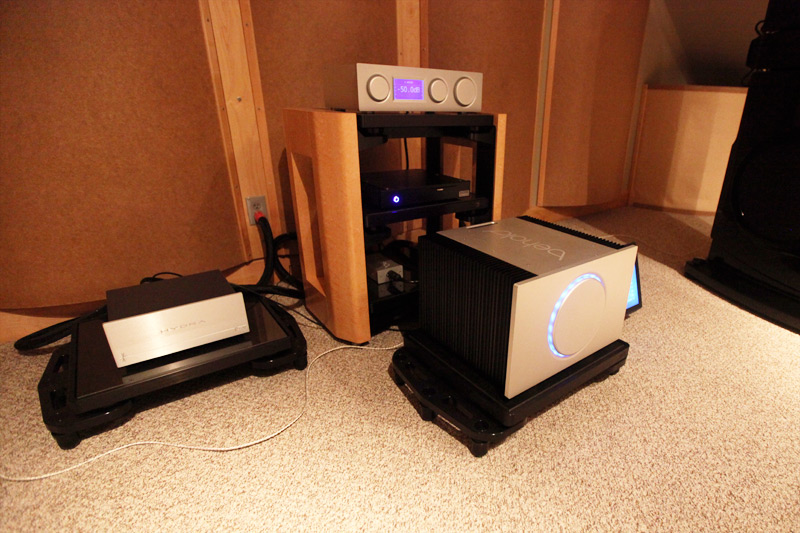
TWBAS electronics and cabling
Installing the Blue Smoke Entertainment Systems Black Box
was a bit more involved, primarily because it required an Ethernet connection to access a
remotely placed hard drive. I snaked wire down inside the living-room wall behind the
cabinet that houses my DSL modem and wireless router, then ran it across the attic and
into the Music Vault, where I tucked it neatly away between baseboard and carpet. Once
this was done, the Black Box was up and running in about 30 minutes, with a little more
phone support from Blue Smoke owner Ron Lapporte. All told, this project was an
evening’s worth of work. Although, as I told Lapporte, I hadn’t looked forward
to routing that cable around and through the house, I’m now glad I have Ethernet in
the listening room. You never know . . .
Behold’s APU768 preamplifier-processor and BPA768
power amplifier-DAC were snaps to get working. Distributor Sam Laufer made sure I had a
fresh APU with all the latest software, and he was right about how impressive this stuff
is in operation. With only a single digital cable connecting the two, the setup time was
minimal. Getting the Room Tools-enabled room correction to work took a bit longer (Ralf
Ballmann, Mr. Behold, should have quite the phone bill after our multiple Germany-to-USA
cellular consultations), but once I’d gotten the IP addresses set correctly to allow
communication (via an Ethernet crossover cable) between my laptop and the APU768, it was a
joy to use. I measured the speakers acoustically with the supplied microphone and stand,
and programmed in four correction curves, none of which we ended up using during the
actual listening. More on that later.
The Thursday before the event was spent repositioning the
speakers, and here was where the expertise of Rockport’s Andy Payor came in. It took
us about five hours of moving and listening, moving and listening, until we finally had
the placements nailed. How far did each speaker end up from my original positions? About
an inch closer to each sidewall, and an inch-and-a-half closer to the listening position.
The system reacted to each tiny movement of the speakers in frankly amazing ways: more
grip in the bass with a quarter-inch of movement outward, more textural information in the
midrange with a slight adjustment of toe-in angle, and so on. It was obvious from this
exercise that the ability of the system to react to minute changes of placement was one of
its overriding characteristics. And after we’d removed the furniture sliders from
under the speakers’ feet and let them sink down into the carpet overnight, the bass
firmed up considerably. Could we have dialed-in the speakers even more? Based on how much
we gained from half a day, I’m sure we could have. But at some point you have to move
on . . .
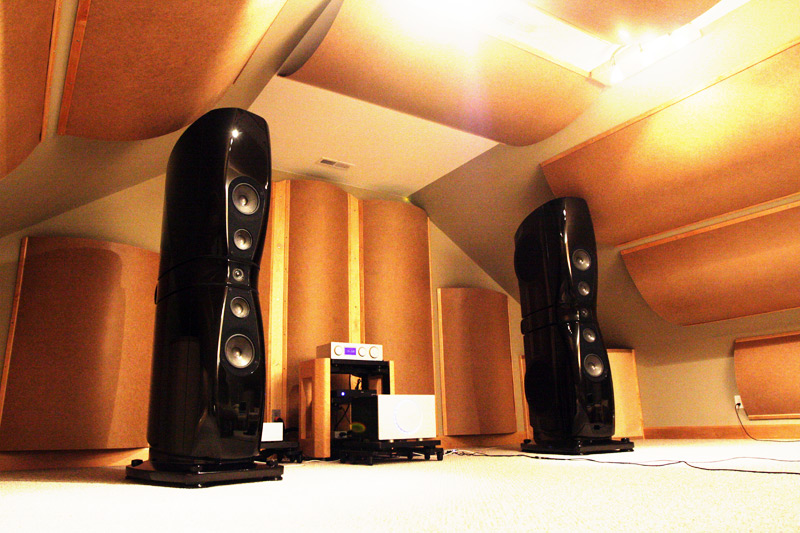
TWBAS 2009
Nothing pleases me.
-- El Greco
Friday was similar to Thursday, only this time we
weren’t repositioning the speakers, but altering their acoustic output to suit the
room. The Behold room-correction system is a powerful tool: the adjustments a user can
make to a system’s frequency response are almost infinite. I learned that it’s
quite easy to achieve flat frequency response, particularly if you start with a good room
and a great pair of speakers, and I had both. But "flat" doesn’t always
improve every sonic parameter. Sometimes flat is close to what you want, but what
really sounds best is a frequency response smoothly contoured in specific ways. By
"smoothly contoured," I don’t mean the jagged peaks and valleys that are
the hallmarks of lesser speaker designs (even before they’re placed in real rooms),
but precisely controlled deviations from flat designed to make the sound come alive in
certain areas.
This is where having some experienced hands at the controls
of a room-correction system can pay huge dividends, and with Rockport’s Andy Payor
and Behold’s Ralf Ballmann at the keyboard, and Andy’s friend and all-around
great guy Harley and me listening, we made what we thought were just the right changes.
(We’d end up making one more adjustment on Saturday morning that would improve things
even more.) However, it should be noted that this slight flavoring of the system was also,
at times, controversial, and actually introduced a little tension to the proceedings.
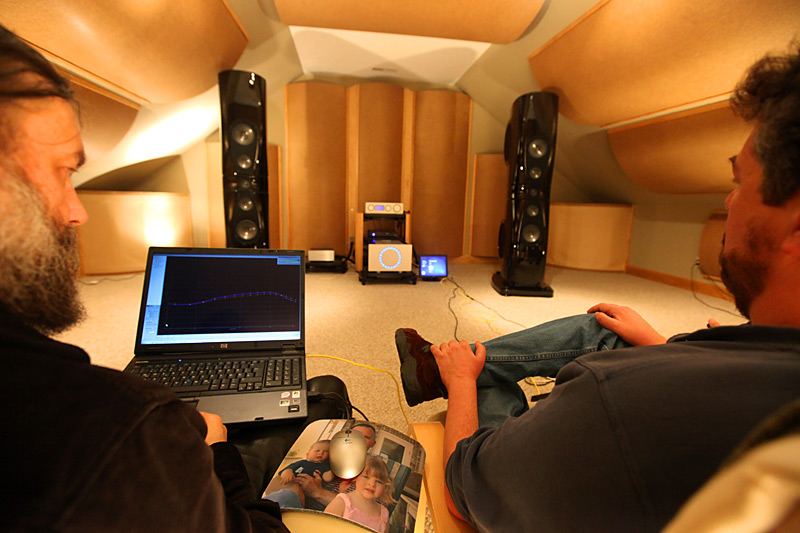
Ralf Ballman and Andy Payor
I chalk it up to this: Many marginal systems can be
improved across the board with room correction. When you begin with a frequency response
that looks like the Swiss Alps, electronically altering the system for a more neutral
response is almost always welcome, in my experience (as long as the room-correction
program itself is mostly transparent, and Behold’s is). However, when the system is
essentially neutral to begin with, slight alterations in tonality can have subjectively
huge consequences that often come down to personal taste. These slight alterations, along
with the adjustable upsampling available via the Blue Smoke Black Box, proved to be the
variables that permitted slight tilts this way or that. Audiophiles are nothing if not
opinionated -- I don’t think we ever got a consensus on which combination of room
correction and upsampling actually produced the best sound. The system was, as Simeon
Sandiford so aptly put it, like a great microscope trained on the music.
Every participant was impressed with the sound we achieved,
but not one of them said, at the conclusion of the weekend, that this was, indeed,
the greatest audio system he or she had ever heard. Having spent a weekend with those
intelligent and perceptive people, I’ve given that fact a lot of thought. I think
each participant in TWBAS 2009 has an internal ideal that he or she tries to attain, a
very specific mental and aural image of what a reproduction in the home of music
being made by live musicians in a physical space might actually sound like. It’s that
ideal that keeps them striving for perfection at their respective companies, and I think
it’s the force that drives them to hit the alarm clock and strap on their
engineer’s (or designer’s, or CEO’s, or president’s) hat every
morning. It could be one or more of these very people who will move us a big step closer
to the fulfillment of every audiophile’s dream of reproduced music that’s
indistinguishable from the real thing.
It was clear to me that every TWBAS 2009 participant had
arrived in Hampstead, North Carolina, with an intense investment in me and the audio
system itself. Each wanted me to be satisfied with the outcome -- the actual sound -- even
if it meant working through some disagreements within the group. Almost everything -- you
name it -- was discussed. Each person attending TWBAS 2009 possessed a real desire to make
the system live up to its name, and each was willing to put her or his expertise on the
line to give us all the best chance of succeeding. At the beginning of the day there was
consensus on some things, not so much on others. By Saturday night, the system sounded
simply fantastic.
I’ve had some amazing systems in my room through the
years, and have spent countless hours listening to music, evaluating components, tweaking
setups, and measuring speakers. But on Sunday night, after everyone had left, as I
listened once again to my TWBAS 2009 Five-Song Demo, I experienced the best sound
I’ve ever heard from my Music Vault listening seat. I took a deep breath as a sense
of contentment welled up inside me.
But how, exactly, did it sound?
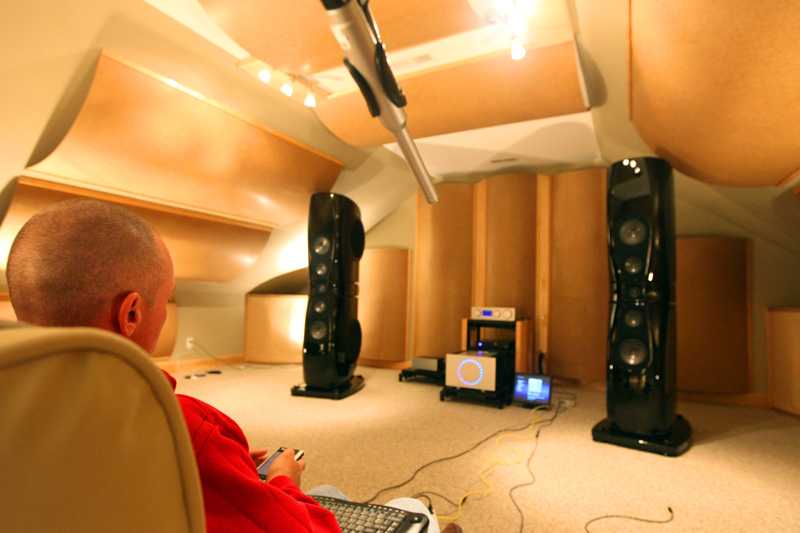
Jeff in the sweet spot
Eden Atwood, "Blame It On My Youth," from This
Is Always: The Ballad Session (CD, Groove Note 10223): This system came as close
to making Atwood actually appear in my room as I have heard. The double bass was perfectly
articulate, and free from the overhang I’ve heard from most every other speaker
system I’ve had in this room. The trumpet was chock-full of low-level detail and
nuance that drew me into the soundstage. The system was able to reproduce each part --
voice, trumpet, bass -- separately, yet seamlessly intertwined into a physical whole.
Bruno Coulais, "Norbu," from the Himalaya
soundtrack (CD, Virgin France 848478): Describing this track in the TWBAS 2009
Five-Song Demo article, I said, "The massive drum thwacks should roll
through your room with supreme authority and frequency extension. You should hear the
initial stroke of mallet on drum head, followed by an evenly distributed, natural decay
that moves like a huge ocean wave from the front to the rear of your room." That was
exactly what I heard from the system on Sunday, but with the addition of one
characteristic I’d not heard before: details within the decay of the impact of
mallet on drum were brought even more to the fore. It was as if the system were letting me
hear past the room interactions and deeper into the sound of the drum itself.
Pretty amazing bass!
Neil Young, "Helpless," from Live at Massey
Hall 1971 (CD, Reprise/WEA 43328): Young’s guitar had a simply
lifelike quality that seemed to be due to the system’s unique ability to re-create
transient attacks with the full impact, speed, and precision that I would have expected to
hear only had I been in Toronto’s Massey Hall way back in ’71. This concert
performance bristled with energy as played back through TWBAS. Yes, goose bumps.
The Fairfield Four, "These Bones," from I
Couldn’t Hear Nobody Pray (CD, Warner Bros. 46698): There was complete tonal
accuracy on this track as heard through TWBAS. The system didn’t seem to want for
anything; it had the midbass-to-midrange capability needed to make the depth of these
voices come alive. The large speakers truly disappeared, highlighting the coherence of the
drivers as their outputs melded together at my listening chair.
Vivaldi: Allegro from Concerto No.3 in G, Op.4
No.3, from La Stravaganza; Rachel Podger, violin; Arte Dei Suonatori (SACD, Channel
Classics CCS SACD 19503): Again, "bristling with energy" seems the best
description of how the system sounded with this track. But it also kept perfect pace and
tempo, not seeming to lag behind the music, as I’ve heard some systems do. This track
sounds good through almost any system, but truly magnificent when played through the best
of the best -- and with TWBAS, it was startlingly good.
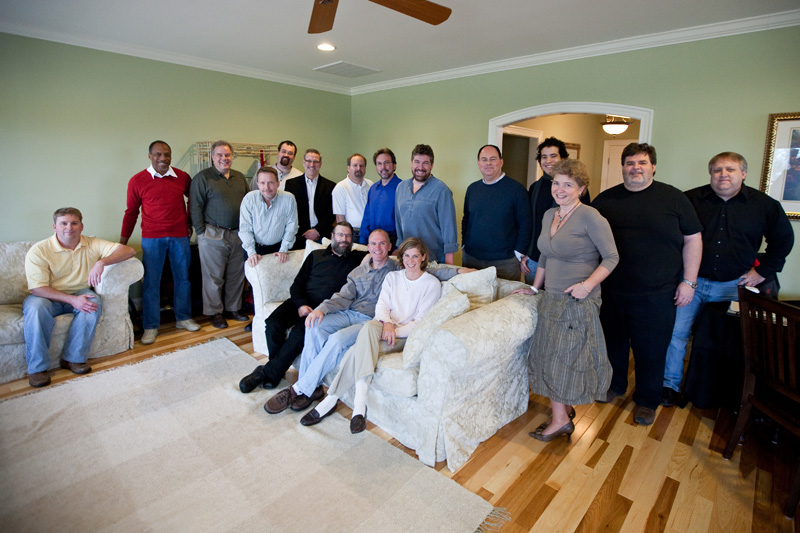
The people who made TWBAS 2009 possible.
In great attempts it is glorious even to fail.
-- Dionysius Longinus
How good, on an absolute scale, was TWBAS 2009? Did it
exceed my expectations? Did it approach the sound of live music?
TWBAS 2009 did not, alas, reproduce music in my room in a
way indistinguishable from a live performance. I think it’s fair to say that the
technology does not yet exist that can re-create with 100% fidelity an orchestral, rock
concert, or jazz-club performance in our homes. Close? No doubt. But perfect? No way, and
don’t let anyone tell you otherwise. Regardless of the hyperbole in ad campaigns,
audio reviews, and Internet message boards and forums, it just isn’t possible . . .
yet.
I’ve taken some criticism for calling my event The
World’s Best Audio System 2009. (Imagine that.) What my critics fail to grasp is that
TWBAS 2009 was not really all about an audio system at all. First, it’s about an effort.
And in mid-March 2009, in Hampstead, North Carolina, Behold, Blue Smoke Entertainment
Systems, Crystal Cable, Harmonic Resolution Systems, Laufer Teknik, Rockport Technologies,
and Shunyata Research all put forth admirable effort that resulted in a sound that was
simply stunning -- everything I’d hoped it would be, and a touch more. I marveled at
their skill and expertise, but most of all I marveled at their passion for music and its
reproduction in the home.
I’m intensely proud of this system, but I’m even
prouder of the people who invested in me and this project.
At the end of the day Sunday, I exhaled -- I’d picked
the right companies after all. I’m also confident that, when a customer buys a
product from any of these firms, he or she is not merely getting a component stuffed in a
box (or some big crates, if you’re buying Rockport Arrakises) -- the buyer is
also getting a personal vision embodied in a product that exists to deliver genuine
musical enjoyment. They’ve all succeeded with what they brought to my home. In my
eyes and ears, their wares represent high achievements, both individually and as assembled
into a system.
He is happiest, be he king or peasant, who finds peace
in his home.
-- Johann von Goethe
"TWBAS" is really a quest, not a physical thing
to be bought and sold. I chose the participants in TWBAS 2009 because I believed they best
represent the high-end-audio ideals that I have nurtured in myself in my more than 20
years as an audiophile. If I hung up my reviewer hat tomorrow and had to live with one
system for the rest of my life, I’d be content knowing it was this one -- and
audiophiles are almost never content. When I listen to TWBAS, the hairs stand up on
the back of my neck and I’m transported to another place and time, where I can revel
in the beauty and joy of music.
Being an audiophile has led me far down a winding road. Now
that TWBAS 2009 is concluded, I can confidently say that I’m even further along
toward my destination. And while I can’t help wondering just how far there might be
still to go, I’m more than happy to continue my journey right here, listening to The
World’s Best Audio System.
. . . Jeff Fritz
jeff@ultraaudio.com
|